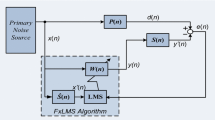Abstract
In this study, hybrid computational frameworks are developed for active noise control (ANC) systems using an evolutionary computing technique based on genetic algorithms (GAs) and interior-point method (IPM), following an integrated approach, GA-IPM. Standard ANC systems are usually implemented with the filtered extended least mean square algorithm for optimization of coefficients for the linear finite-impulse response filter, but are likely to become trapped in local minima (LM). This issue is addressed with the proposed GA-IPM computing approach which is considerably less prone to the LM problem. Also, there is no requirement to identify a secondary path for the ANC system used in the scheme. The design method is evaluated using an ANC model of a headset with sinusoidal, random, and complex random noise interferences under several scenarios based on linear and nonlinear primary and secondary paths. The accuracy and convergence of the proposed scheme are validated based on the results of statistical analysis of a large number of independent runs of the algorithm.
Similar content being viewed by others
References
Ahmad I, Raja MAZ, Bilal M, et al., 2017. Neural network methods to solve the Lane-Emden type equations arising in thermodynamic studies of the spherical gas cloud model. Neur Comput Appl, 28(Suppl 1):929–944. https://doi.org/10.1007/s00521-016-2400-y
Akhtar MT, Nishihara A, 2015. Data-reusing-based filteredreference adaptive algorithms for active control of impulsive noise sources. Appl Acoust, 92:18–26. https://doi.org/10.1016/j.apacoust.2015.01.006
Akhtar MT, Abe M, Kawamata M, 2006. A new variable step size LMS algorithm-based method for improved online secondary path modeling in active noise control systems. IEEE Trans Audio Speech Lang Process, 14(2):720–726. https://doi.org/10.1109/TSA.2005.855829
Chang CY, Shyu KK, 2003. Active noise cancellation with a fuzzy adaptive filtered-X algorithm. IEE Proc Circ Dev Syst, 150(5):416–422. https://doi.org/10.1049/ip-cds:20030406
Chang CY, Luoh FB, 2007. Enhancement of active noise control using neural-based filtered-X algorithm. J Sound Vib, 305(1-2):348–356. https://doi.org/10.1016/j.jsv.2007.04.007
Chang CY, Chen DR, 2010. Active noise cancellation without secondary path identification by using an adaptive genetic algorithm. IEEE Trans Instrum Meas, 59(9):2315–2327. https://doi.org/10.1109/TIM.2009.2036410
George NV, Panda G, 2012. A particle-swarm-optimizationbased decentralized nonlinear active noise control system. IEEE Trans Instrum Meas, 61(12):3378–3386. https://doi.org/10.1109/TIM.2012.2205492
George NV, Panda G, 2013. Advances in active noise control: a survey, with emphasis on recent nonlinear techniques. Signal Process, 93(2):363–377. https://doi.org/10.1016/j.sigpro.2012.08.013
Gholami-Boroujeny S, Eshghi M, 2012. Non-linear active noise cancellation using a bacterial foraging optimisation algorithm. IET Signal Process, 6(4):364–373. https://doi.org/10.1049/iet-spr.2011.0092
Gholami-Boroujeny S, Eshghi M, 2014. Active noise control using an adaptive bacterial foraging optimization algorithm. Signal Image Video Process, 8(8):1507–1516. https://doi.org/10.1007/s11760-012-0385-2
Gotmare A, Bhattacharjee SS, Patidar R, et al., 2017. Swarm and evolutionary computing algorithms for system identification and filter design: a comprehensive review. Swarm Evol Comput, 32:68–84. https://doi.org/10.1016/j.swevo.2016.06.007
Hoseini P, Shayesteh MG, 2013. Efficient contrast enhancement of images using hybrid ant colony optimisation, genetic algorithm, and simulated annealing. Dig Signal Process, 23(3):879–893. https://doi.org/10.1016/j.dsp.2012.12.011
Iacca G, Caraffini F, Neri F, 2013. Memory-saving memetic computing for path-following mobile robots. Appl Soft Comput, 13(4):2003–2016. https://doi.org/10.1016/j.asoc.2012.11.039
Kuo SM, Morgan D, 1995. Active Noise Control Systems: Algorithms and DSP Implementations. John Wiley & Sons, Inc., New York, USA.
Kurczyk S, Pawelczyk M, 2014a. Active noise control using a fuzzy inference system without secondary path modelling. Arch Acoust, 39(2):243–248. https://doi.org/10.2478/aoa-2014-0028
Kurczyk S, Pawelczyk M, 2014b. Active noise control without secondary path modelling—varying-delay LMS approach. IEEE 19th Int Conf on Methods and Models in Automation and Robotics, p.134–139. https://doi.org/10.1109/MMAR.2014.6957338
Raja MAZ, Khan JA, Chaudhary NI, et al., 2016a. Reliable numerical treatment of nonlinear singular Flierl-Petviashivili equations for unbounded domain using ANN, GAs, and SQP. Appl Soft Comput, 38:617–636. https://doi.org/10.1016/j.asoc.2015.10.017
Raja MAZ, Zameer A, Khan AU, et al., 2016b. A new numerical approach to solve Thomas-Fermi model of an atom using bio-inspired heuristics integrated with sequential quadratic programming. SpringerPlus, 5(1):1400. https://doi.org/10.1186/s40064-016-3093-5
Reeves C, 2010. Genetic algorithms. In: Glover FW, Kochenberger GA (Eds.), Handbook of Metaheuristics. Springer, New York, p.55–82.
Rout NK, Das DP, Panda G, 2012. Particle swarm optimization based active noise control algorithm without secondary path identification. IEEE Trans Instrum Meas, 61(2):554–563. https://doi.org/10.1109/TIM.2011.2169180
Sivanandam SN, Deepa SN, 2007. Introduction to Genetic Algorithms. Springer, Heidelberg.
Tan L, Jiang J, 2001. Adaptive Volterra filters for active control of nonlinear noise processes. IEEE Trans Signal Process, 49(8):1667–1676. https://doi.org/10.1109/78.934136
Tan XH, Shen RM, Wang Y, 2012. Personalized course generation and evolution based on genetic algorithms. J Zhejiang Univ-Sci C (Comput & Electron), 13(12):909–917. https://doi.org/10.1631/jzus.C1200174
Wu B, Ma JT, Wu P, 2014. Implement an indoor low frequency noise reduction system based on FXLMS algorithm. Appl Mech Mater, 667:440–447. https://doi.org/10.4028/www.scientific.net/AMM.667.440
Zhang L, Lampe M, Wang Z, 2011. A hybrid genetic algorithm to optimize device allocation in industrial Ethernet networks with real-time constraints. J Zhejiang Univ-Sci C (Comput & Electron), 12(12):965–975. https://doi.org/10.1631/jzus.C1100045
Zhang M, Lan H, Ser W, 2001. Cross-updated active noise control system with online secondary path modeling. IEEE Trans Speech Audio Process, 9(5):598–602. https://doi.org/10.1109/89.928924
Zhou DY, DeBrunner V, 2007. Efficient adaptive nonlinear filters for nonlinear active noise control. IEEE Trans Circ Syst I, 54(3):669–681. https://doi.org/10.1109/TCSI.2006.887636
Author information
Authors and Affiliations
Corresponding author
Electronic supplementary material
11714_2018_1224_MOESM1_ESM.pdf
Bio-inspired heuristics hybrid with interior-point method for active noise control systems without identification of secondary path
Rights and permissions
About this article
Cite this article
Raja, M.A.Z., Aslam, M.S., Chaudhary, N.I. et al. Bio-inspired heuristics hybrid with interior-point method for active noise control systems without identification of secondary path. Frontiers Inf Technol Electronic Eng 19, 246–259 (2018). https://doi.org/10.1631/FITEE.1601028
Received:
Accepted:
Published:
Issue Date:
DOI: https://doi.org/10.1631/FITEE.1601028
Key words
- Active noise control (ANC)
- Filtered extended least mean square (FXLMS)
- Memetic computing
- Genetic algorithms
- Interior-point method




